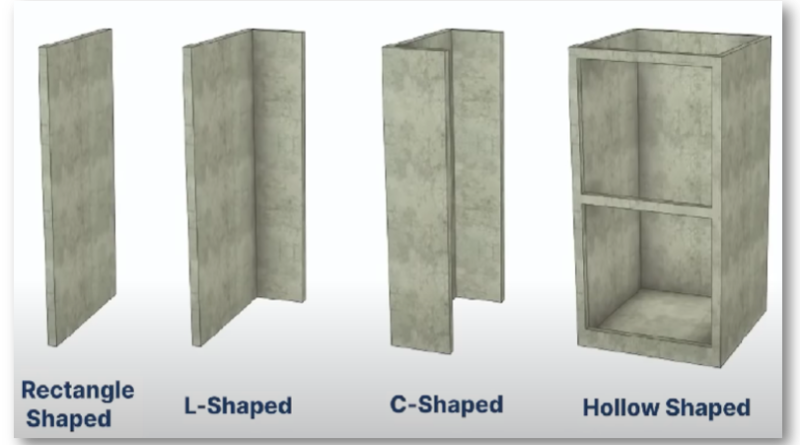What is a Shear Wall and Where is it Used ? Advantages and Purpose
Shear wall is a structural member used to resist lateral forces that are designed to resist in-plane lateral forces, typically wind and seismic loads. It resists the loads due to Cantilever Action. In other words, Shear walls are vertical elements of the horizontal force resisting system .
A shear wall is a vertical structural feature of a structure that is designed to withstand lateral stresses such as wind and earthquakes. Shear walls, which are often composed of reinforced concrete, are positioned in the vertical plane of a building’s structure and are essential in giving stability and rigidity to the structure. They are often employed in high-rise buildings, residential dwellings, and other structures in places prone to earthquakes or high winds, and serve an important role in minimising a building’s displacement during lateral stresses.
Normal wall vs shear wall
A normal wall is a non bearing wall also called a demising wall or dividing wall. They serve limited structural value and are not attached to the foundation or to a structural diaphragm in a meaningful way. There main purpose is to divide areas in a building into rooms or other areas.
A shear wall is used to resist the shear forces applied to a building. These forces normally come by wind or earthquake and are perpendicular to the exterior walls. A shear wall needs to be attached to another structural member of the building to resist these forces primarily the foundation. Another component is that part of the shear forces being combated by a shear wall are tipping forces. When a shear wall is built the forces that would have caused it to rack are now trying to lift the corner of the wall and this is why it must be connected to a foundation.
In a framed building the shear walls are generally attached to and support the exterior walls. Without shear walls supporting the exterior walls against wind and earthquake loads, the exterior walls would collapse inward. They brace the exterior walls. Building codes call for shear walls every so many feet to prevent this kind of collapse.
Functions of shear walls
- Resist Lateral loads, Seismic loads, Vertical Forces (gravity)
- Reduces lateral sway of the building
- Provide large strength and stiffness to buildings in the direction of their orientation
- The rigid vertical diaphragm transfers the loads into Foundations
- Provide large strength and stiffness in the direction of orientation
- Significantly reduces lateral sway
- Well-distributed reinforcements
- Minimize damages to structural and Nonstructural elements

What are the Advantages of shear wall?
Shear walls have various benefits in modern building design. Shear walls provide the following advantages:
- Increased Structural Stability: Shear walls are designed to withstand lateral stresses such as wind and seismic loads, giving the structure with stability and rigidity. They are a crucial component of contemporary building design, assuring the building’s safety and stability under harsh weather conditions.
- Improved Durability: Shear walls are composed of reinforced concrete or masonry, which provides increased durability and resilience to wear and strain. They can survive high-stress circumstances for an extended length of time, assuring the building’s lifespan.
- Space Optimisation: Shear walls can be placed at the building’s perimeter or core, allowing for more effective use of space within the structure. This implies that structural parts require less space, allowing for greater useable floor area.
- Energy Efficiency: Shear walls may also help a building’s energy efficiency. They use less energy to maintain the ideal interior temperature because they give structural stability, resulting in cheaper energy expenses.
- Aesthetics: Shear walls may also be employed as decorative components in modern construction. They can be incorporated into the outer façade or interior design of a building, providing a distinctive and appealing aspect to the structure.
Where shear walls can be applied?
Here are the steps explaining where shear walls are used:
- Shear walls may be found in a variety of constructions, including reinforced concrete structures, masonry structures, and steel frame structures.
- They are especially useful in high-rise structures, where lateral forces like as wind and seismic loads can produce substantial structural stress.
- Shear walls are often situated on the building’s perimeter or in its core to offer stability and rigidity to the structure.
- The number and position of shear walls in a structure are determined by design and construction requirements such as building height, seismic activity in the area, and wind loads.
- Shear walls in reinforced concrete structures can be constructed by creating reinforced concrete walls around the perimeter or core of the building.
- Shear walls in steel frame constructions can be formed using steel plates or composite materials to form a braced frame or moment frame.
- Shear walls are an important component of contemporary building design, providing structural stability and safety in places prone to lateral stresses.

